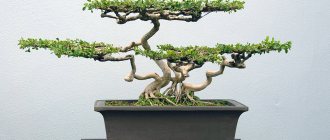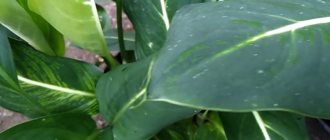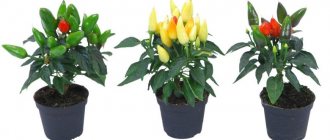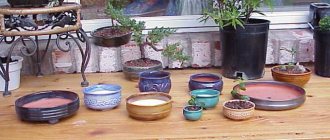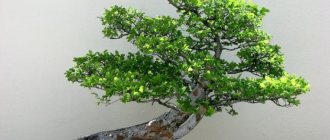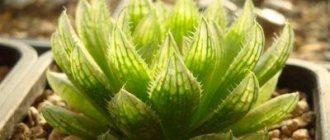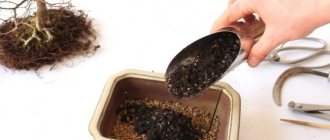According to legend, the Chinese emperor decided to observe his country with his own eyes, for which the masters of the Celestial Empire had to create tiny copies of houses, people and, of course, trees.
Bonsai, a tree in miniature, first conquered Japan almost fifteen centuries ago, and today this amazing art has conquered the whole world. Like many centuries ago, the goal of a gardener passionate about bonsai is to reproduce the creations of nature itself. Small copies of oaks, maples, pines, sakura or ficus trees have realistic proportions, they live according to nature’s routine. If a deciduous tree is grown in a pot, it blooms, becomes covered with leaves and goes into winter dormancy.
Because the craftsmanship of a real tree is shaped by hand, growing and caring for a bonsai is labor-intensive, time-consuming, and requires knowledge, patience, and an understanding of your green pet's needs.
And yet, more and more newcomers are enthusiastically taking on difficult but very exciting work. How to grow a bonsai at home and care for a small copy of a real tree?
Among those uninitiated in the intricacies of ancient agricultural technology, there is an opinion that Japanese bonsai trees are plants obtained from special seeds. This is wrong. Experienced flower growers know very well that miniature spruce, pine, apple or wisteria trees emerged from ordinary seeds, and only human hands could make them moderate their growth and change their shape. Find out how tall a sequoia is!
How to grow a bonsai tree
Bonsai is not just a gardening technique, it is an entire Eastern philosophy. It develops patience and is great for relaxation and contemplation. Caring for bonsai can be compared to meditation, when a person is completely immersed in his activity. Bonsai can be with you until the end of your days. In fact, the ancient Chinese believed that those who could care for a miniature tree for a long time had eternity granted to their soul. For them, a tree can be a connection between a saint and a person, between heaven and earth.
The first records of people growing bonsai were found in China. Contrary to popular belief, bonsai trees are not genetically dwarf plants. They are kept miniature due to special growing conditions. You can grow a bonsai tree with your own hands at home, the main thing is to know how to do it correctly.
How to choose a tree type
Growing bonsai at home begins with choosing a tree. There are several options suitable for beginner bonsaiists. These are Chinese elm and Japanese black pine. Any tree can be a bonsai. Many people prefer species with small leaves; they are easier to model. There are other considerations that need to be taken into account when planning your miniature. You can start from scratch, which means buying seeds from a store or collecting them near your home or in the wild.
To determine which tree to grow bonsai from, you should understand what is more important to the gardener: foliage or needles, flowering and fruiting, and the unpretentiousness of the plant. Flowering bonsai can be obtained from many crops (azaleas, apple trees, cotoneasters, cherries, citrus fruits, camellias, gardenias). If your bonsai trees are deciduous, their leaves will change color and fall off with the seasons.
You can find a stock plant, called by professionals “prebonsai” (rooted sapling). This makes the process faster, although growing bonsai is a good exercise for training patience. The last option may be the simplest and least educational - buying a mature bonsai. The owner will only need to take care of it and perform timely maintenance.
More on the topic:
How to Grow a Money Tree Bonsai
More on the topic:
All about bonsai at home
Choosing a seedling for bonsai
The types of bonsai trees depend on the environment in which it will be grown. The climate and furnishings of the home must be taken into account. Beginners should prefer plants that grow in their region.
- Deciduous species (Chinese or Japanese elms, magnolias, oaks and apple trees) are good choices for outdoor growing.
- An excellent choice of conifers are juniper, pine, spruce or cedar.
- If you want to grow a miniature indoors (or if you live in a hot climate), consider a tropical variety. Jade, snow and olive trees can be grown as a miniature garden.
Choosing a seedling in nature
If you like the option of digging up a seedling in a forested area, pay attention to a number of factors:
- Choose a sprout with a strong trunk, but still young. Old plants do not adapt well to new conditions.
- The sprout should have roots evenly distributed in all directions.
- Dig around and remove a large amount of soil along with the roots. This will prevent the plant from dying from impacts during transportation.
- Plant the dug up seedling in a “training” container.
Wait about a year for the roots to get used to the container before transplanting it into a special container.
Buying bonsai in a store
This is the easiest and most expensive way to start growing live miniatures. Bonsais that have been grown from seed have already received a lot of time and care from their creators, which is why they are expensive. If you buy a ready-made bonsai from a store, talk to someone who knows its history and characteristics. When you bring him home, give him a few weeks to adjust to his new surroundings. Growing bonsai from seed is considered traditional for the classical Japanese school.
As Japanese wisdom says: the art of Bonsai is not a race, it is an endless journey.
How to grow bonsai at home: common methods
If a gardener is just beginning to become interested in bonsai, the easiest way is to purchase a plant that has already been formed, for example from a ficus or citrus tree. It will help you master all the care techniques from regular watering to pruning and adjusting the shape of the trunk and branches. The accumulated experience will allow you to move on to more complex tasks.
There are several ways to grow bonsai at home:
- through sowing the seeds of the crop you like and the subsequent “education” of the seedling;
- using a rooted cutting;
- forming a seedling from a nursery or wild nature;
- transferring an already adult cultivated or wild specimen into a pot and correcting it.
The fastest of the listed methods is the formation of the crown and root system of a one- or two-year-old seedling. Such a plant already has developed roots, while its above-ground part gives room for imagination and can be modified according to the gardener’s plans.
Enthusiasts interested in how to grow bonsai from seeds should know that this path is the longest, but also rewarding. Here, a person has control over the plant literally from the moment the seed is pecked, and changing the shape of the shoots and roots is easier because of their flexibility.
It is not necessary to choose an exotic type of tree or shrub. The main thing is that the plant has small leaves and small annual growth, otherwise it will be much more difficult to “tame” the future bonsai tree.
Bonsai pot
Choosing the right bonsai pot is not easy. In professional literature they are called bowls. This dish has a unique shape and does not look like the usual pot for indoor plants.
These containers are manufactured in factories, or can be made to order by a potter based on an individual project. The second option has a very high cost, but is an exclusive product.
A distinctive feature of bonsai trees is that they are planted in pots that limit root growth.
The most important factor when deciding which pot to use is to make sure the pot is large enough for the soil to cover the plant's roots. To prevent root rot, you should also make sure your pot has one or more drainage holes in the bottom. If not, you can drill them yourself.
Selecting sizes
The first criterion for a pot is the size of the bowl. The pot must be large enough. You must maintain the aesthetics of your miniature. Pots that are too large can spoil the appearance of the bonsai, creating an odd appearance. Some people grow their arrangement in simple pots and then move them to nicer ones. This is useful if your plant is still fragile. The depth should be equal to the diameter of the bonsai trunk.
- For oval or rectangular shapes, the length should be 2/3 of the height of the tree.
- For round ones, the diameter should be 1/3 of the height.
- Miniatures with a wide crown may require a wider bowl.
- Specimens with a thick trunk require a deeper container.
These recommendations are based on aesthetics. Some types of trees require larger or smaller pots. Trees with fast-growing roots need deeper containers.
Thumbnail style
Rectangular or oval shapes are used for vertical and slanted trees. Literatures are placed in small round pots. For cascading compositions, a deep round, square, hexagonal or octagonal shape is used. The gallery below contains photos of a wide variety of bonsai pot options.
Feeding and fertilizer
When growing bonsai, it is important to slow down its growth. In a cramped pot, you can create conditions for the controlled growth of a tree, but it is difficult to ensure the supply of necessary substances from the soil. Fertilizing is necessary so that the plant does not die, but you need to select fertilizer taking into account the type of tree, its age, and time of year. Macro- and microelements should be added periodically. Basic feeding includes potassium, nitrogen and phosphorus. Magnesium, zinc, calcium, copper, boron, molybdenum and other trace elements are added less frequently and in limited quantities.
The beginning of feeding coincides with the activation of growth. In the spring, nitrogen-phosphorus-potassium fertilizer is applied and fertilizing is repeated every month until mid-summer. Then you should take a break until the beginning of autumn, a series of fertilizing continues until the onset of the dormant period.
Advice. Apply more nitrogen in the spring, and increase the potassium content in the fertilizer in the fall. Flowering and fruiting bonsai should receive phosphorus.
Complex mineral fertilizers for bonsai are optimally suitable for tree care. The packaging indicates the proportions and frequency of fertilizer corresponding to the size of the plant and its condition.
Advice. It is convenient to add dissolved fertilizers to the tray under the pot so that the soil is completely saturated
How to place a bonsai
The miniature in an oval or rectangular container should be placed slightly behind the center line of the container. Depending on the shape of the tree, it should be slightly left or right of center.
Plants with a long first branch going to the right should be planted slightly to the left. This gives a "picture" balance. If the first branch grows to the left, then the tree is planted to the right of the center of the container.
The exception to the rule is square and round bowls. In them the composition is placed in the center. This also applies to cascading miniatures. In this case, the root system does not always allow such positioning.
How to identify a tree?
There are several signs:
- Pronounced root system.
- Clear branches, the course of which can be followed.
- The trunk can be seen even through the foliage.
- Similarity to the original tree.
Should there be glaze on the pots?
- Unglazed examples are earthy in color, ranging from light brown to dark brown, rusty brown to red-brown.
- Earthy colors are suitable for coniferous and dense deciduous compositions. The dense greens or blue-green foliage of conifers tend to pair well with shades of brown.
- Glazed ones can have different colors. It is important to make sure that the icing inside is no more than a third of the way deep. The color of the glaze is selected and complements one of the colors of the main elements or features of your bonsai. This can be the color of leaves, bark, fruits.
Basic recommendations for choosing a bonsai pot
Bonsai pots are often compared to a painting frame by bonsai artists. They should emphasize the grace and aesthetics of the composition, frame, and not distract attention to themselves. The correct product must meet certain criteria. The condition and health of the composition depends on the quality of the container.
- The pot must be large so that the tree's roots can grow freely. The ends of the roots absorb moisture and nutrients. Therefore, they should have enough free space.
- Replanting a tree does not mean increasing the size of the container. If the bonsai has already been formed and regular pruning of the roots and crown is carried out, you can replant the plant in the same bowl, simply replacing the soil.
- The larger the pot, the less often the composition is watered.
- Ideally, the length of a bonsai should be approximately 2/3 of the height of the tree. If its height is shorter than its width, the length of the pot should be 2/3 of the width of the plant.
- The shape should match the bonsai style. For compositions with straight trunks, rectangular containers are better suited. Curved barrels look best in round, oval or rectangular bowls. It is better to plant a strong and powerful tree in a container with right angles.
How to choose material
A good bonsai pot should have drainage holes and wiring holes so that your tree can be attached to the container. They are made from:
- ceramics;
- porcelain;
- concrete;
- clay;
- mica;
- metal;
- tree.
Metals can release toxins. The use of plastic containers does not correspond to the philosophy of bonsai and is considered bad manners among experienced craftsmen. A classic pot is made of porcelain or ceramics. These materials absorb moisture, which has a positive effect on plant health and drainage. A true Japanese bonsai only has clay pots. For especially valuable specimens, they are made to order and individual style.
Forming and laying technique
When we bought or grew a seedling, it’s time to start shaping and styling it. This is the creative part of growing bonsai and the most difficult. Pine bonsai, properly stylized, look especially impressive. While miniaturization techniques have taken a long time to perfect, some basics can be learned quite easily.
The most important technique for bonsai is pruning. It is necessary for miniaturization and structure formation. The goal is to create a unified look that is as close to nature as possible. Spring and summer are the best time to prune, but it depends on the type of plant. When pruning thick branches, a good concave knife is a must. The wounds left by these incisors heal much better than regular scissors. It is impossible to tell which branches need to be pruned to form a bonsai without seeing it. Some examples of when they should be removed:
- If two branches appear at the same height, leave one and prune the other.
- The branches have unnatural turns.
- Disproportionally thick branches at the tops.
Another important technique for shaping bonsai trees is wire. It is made from anodized aluminum or annealed copper. The wire is wrapped around the branches. This way they can be bent and shaped into the desired shape, at least to a certain extent. This technique can be used year-round, but be sure to remove the binding before it begins to scar the branches, which become thicker.
Choosing a pot and soil for bonsai
It is not for nothing that the bonsai tree is called tray-grown. To limit the pet’s growth, it is planted in a deliberately small and shallow container, while simultaneously forming and cutting off part of the root system.
When choosing a bonsai pot, you need to take into account that over the years the tree becomes heavy and, especially with an irregular, inclined or cascading shape, may lose stability. Therefore, for bonsai, ranging in size from a few centimeters to 9 meters, massive, often ceramic pots, bowls or containers of various shapes and styles are traditionally made.
There should be a drainage hole at the bottom of the container and more than one. They are used not only to drain water, but also to secure the plant.
Treating the bonsai pot with a hot solution of potassium permanganate or scalding with boiling water will help protect the plant and protect it from fungal infection of the root system.
Bonsai soil is not only designed to provide the plant with nutrition and retain moisture, it should help the roots to gain a foothold in the relatively small volume of the pot. Therefore, for miniature copies of real oaks, lindens, lemons, maples and other trees, a special substrate is used.
In Japan, for many centuries, such a mixture based on certain types of clay is called akadama. For greater nutritional value and looseness, fertile soil and sand are added to the granular substance:
- For deciduous bonsai trees, a substrate containing 7 parts of turf soil and 3 parts of coarse washed sand is recommended.
- Flowering crops are grown on a mixture of 7 parts turf soil, three parts sand and 1 part highly nutritious humus.
- Coniferous species, the most popular among bonsai lovers, need particularly loose soil, for which take 3 parts turf soil and 2 parts washed sand.
Before filling the pot, the bonsai soil is sorted out, removing foreign matter that could damage the roots, sifted and sterilized. A drainage layer is placed at the bottom of the container to drain excess moisture.
Bonsai care
Each bonsai tree, when at home, requires special care. There are specific recommendations for each type. Be sure to check them out for yours! There are general guidelines that are suitable for indoor bonsai. The frequency of watering bonsai depends on a whole range of factors:
- view;
- dimensions;
- pot size;
- soil quality;
- climatic conditions.
Overwatering can lead to root rot, the most common cause of plant death. Because bonsai are planted in small pots, they dry out very quickly. Selecting the right soil mixture and planting regularly, on average every two years, to ensure the tree's roots are not restricted by the pot. An important rule of watering is to frequently check the dryness of the soil. It is important to do this after watering to ensure that the soil has absorbed the water well.
Unusual ceramic figures often decorate Bonsai pots and make the composition even more like a wonderful forest.
Apart from watering and replanting, fertilizer is another important thing that needs to be used regularly. Since trees are placed in small pots with little space and available nutrients, regular fertilization while the tree is growing is key to maintaining its health.
Placing an outdoor type bonsai in an apartment and vice versa can kill the bonsai. Before you buy, decide on where to place it.
Subtropical varieties usually need plenty of light and relatively high temperatures and can only live outside if you live in a warm enough climate.
If you prefer a street tree, choose ones that are natural to your climate. If winters become very cold, additional frost protection may be required.
How often do you water a bonsai?
To grow bonsai at home, you first need to know how often you need to water, depends on too many factors. You need to monitor your trees individually. Water the plant when the soil becomes a little dry. You should not water while the soil is still damp, but only when it feels slightly dry.
Use the correct soil mixture. The soil mixture affects the frequency of watering. For bonsai, a mixture of akadama, pumice and expanded clay, mixed in a ratio of ½ to ¼ to ¼, is suitable. Use a mixture that holds more water (using more akadam or compost in pots) when you cannot water the trees regularly.
You can simply check with your fingers. The soil ball should be moist to a depth of 1 cm. Do not allow the soil to dry out completely! Experienced bonsai growers determine the frequency of watering intuitively.
How to grow?
Be prepared to take care of your plant for several years. First for the seed, then for the sprout and finally for the tree.
To get started, you will need a special kit consisting of:
- Instructions.
- Ground.
- Pot.
- Semyon.
- Fertilizers.
Over the long term you will need:
- Trim the plant.
- Maintain soil in favorable condition.
- Maintain temperature (10-18 degrees).
- Avoid exposure to sunlight.
- Prevent drafts.
- Water the plant on time.
Periodically, nitrogen, phosphorus and potassium must be added to the fertilizer. And be patient.
How often to replant
It depends on the size of the pot and the tree. Fast-growing plants need to be replanted every two years, sometimes every year. If the bonsai is old - every three to five years.
Check your miniature every early spring by carefully removing the tree from its pot. A bonsai should be repotted if its roots are curling around themselves. Transplant stages:
- Make sure you have the right tools to repot your bonsai. For this you will need: scissors, wire cutters, chopsticks.
- Trees are often tied to the pot in which they are planted by their roots. In this case, cut the wire.
- Carefully remove the tree from the bowl.
- Assess the need for replanting (the condition of the roots and the degree of their curl).
- Use a chopstick to remove old soil, starting from the sides and bottom. Be careful not to damage the roots. When replanting pine trees, leave at least half the root mass needed for the tree's survival.
We replant the tree in the same pot, covering the drainage holes with mesh. All movements must be careful so as not to damage the trunk, branches and roots of the plant.
Bonsai transplant
The first year of life the tree should grow without external intervention, and in the next seven years the bonsai is replanted every year, later every two years. The best time for replanting is March-April, because with the onset of spring the tree will be provided with light and warmth for adaptation. After removing the plant from the pot, inspect the roots and remove any diseased or drying ones. If the root system appears unhealthy, the replanting soil should contain gravel.
The transplant proceeds as follows:
- Stop watering the plant for two days so that the roots can be easily cleared of the soil.
- On the day of transplantation, the new pot is washed, disinfected and rinsed.
- The drainage hole is covered with a shard or mesh.
- Transplantation is quick because the roots are sensitive to light and air.
- Holding the plant firmly on the trunk, run a knife along the walls of the pot and remove the tree with a lump of earth.
- The soil is removed by a third on all sides.
- Diseased and dried roots are cut off, the rest are slightly shortened.
- A thin layer of fresh soil is placed at the bottom of the pot.
- The plant is placed in a new pot and the roots are straightened.
- Asymmetrically shaped trees are placed closer to the edge of the pot, symmetrical ones - in the center.
- The roots should be visible above the surface, but not too high.
- If the root system is weak, the plant is secured with wire through a drainage hole to which a wooden stick is attached.
- Add soil, filling the voids between the roots and at the edge of the pot. The soil is compacted with your fingers.
- Water the bonsai until water seeps through the drainage hole.
- The pot is placed in a well-lit place without drafts or scorching sun.
- New roots will form in a month.
Pruning and crown formation
The goal is to maintain and correct the shape of the bonsai. Trees will concentrate their growth on the top and outer parts. It is important to trim these areas regularly to encourage growth closer to the inner parts of the trunk. Pruning can be carried out throughout the growing season - from March to September.
You can trim branches and shoots that have outgrown the intended size and do not correspond to the intended design. The formation of the bonsai crown is carried out with scissors or a branch cutter. Don't be afraid to prune your bonsai, especially the outer and top parts. Regular pruning will force the tree to spread its growth evenly and develop dense foliage.
Unlike deciduous trees, coniferous trees must be pinched by hand. Using scissors will result in the death of needles on the shoots. To prevent this from happening, hold the tip of the process with your thumb and forefinger and gently move it away. The shoot will break at its weakest point and no brown ends will appear. Different types of trees require different care. Some require a combination of both - scissors and hand.
Another radical pruning method is defoliation. This is removing leaves during the summer to force it to produce new leaves. This technique results in reduced leaf size and high branching.
Bonsai structural pruning
To give the tree shape, it is necessary to trim large branches. Deciding which ones to keep and which ones to remove can be difficult because it is part of deciding what the tree will look like. Early spring and late fall are good times to trim your miniatures. To carry out such pruning, you need:
- place the bonsai at eye level;
- remove dry branches and leaves;
- inspect and decide which branches do not conform to the desired design and should be removed.
Trimming thick branches will cause unsightly scars on the tree. By using a special concave cutter, you will reduce this effect due to the resulting indentation when cutting.
A healthy tree has no problem trimming 1/3 of its foliage. Experienced bonsaists recommend pruning in one approach, and then only maintaining its shape.
It is recommended to seal large cuttings with paste, which can be purchased at bonsai stores. This composition protects against infections and helps the tree heal faster.
How to wrap a bonsai
Winding is a difficult technique for beginners to master. Try connecting two branches of the same thickness next to each other with one piece of wire where possible, and connect the remaining branches separately.
When winding the wire, you should go from the trunk to the primary branches. Then to the secondary ones. Use wire 1/3 the thickness of the branch you are forming. The wire must be thick enough to hold the branch in its new shape.
Double wiring bonsai
Select a couple of branches to tie together. They should be the same thickness and located next to each other. The wire should be wrapped around the trunk at least once to prevent the wire from moving when the branches bend. Now cut the required length of wire to wrap both branches.
Start by wrapping the trunk, moving to the first branch. Wrap from its base to the end before starting another. The wire is wound at an angle of 45 degrees. This way, the wrapping will allow the wood to grow thicker while maintaining its new shape. When bending branches down the trunk, make sure the wire also runs underneath. The winding must pass from above if it is directed upwards.
Bending wire branches
After wrapping, you can begin bending and moving the branches. Hold the outer part with your fingers and bend it in the desired direction. This reduces the risk of breaking a branch. The branches need to be bent in their natural position.
Ficus benjamina bonsai
Ficus benjamina bonsai can be grown in Japanese style. Given the large leaves of this plant, you need to plan for a minimum tree height. The optimal height is about 50 cm. Pruning begins when the plant reaches a height of 10-20 cm. The branches and trunk of the ficus remain elastic for a long time.
Even old woody branches can be oriented in the right direction with the help of wire. The ficus tree quickly grows in thickness, you need to constantly monitor the tying. It is often necessary to trim branches back almost to the trunk to maintain the trees' compact shape.
Ficus bonsai pruning
If the goal is to create and maintain a miniature tree, careful modeling and regular maintenance will be required from time to time. When forming a structure, you find that one of the most difficult things is deciding which branches fit the design and which need to be removed. Pruning ficus trees for bonsai takes a long time. Ficus tends to shed its leaves and take on a long form. There is a wide range of techniques that help create and maintain the miniature size and shape of a bonsai tree. Trimming and wiring are the most important ones.
It is recommended to accept the basic shape of the tree as is and try to avoid radical changes. Determine what the front part of the ficus bonsai should be. This will make it easier to determine which branches should be trimmed to improve the overall design. Regular pruning is important so that the ficus can grow dense foliage and form a branching structure in the desired shape.
Bonsai wrapping
Along with pruning, wiring is a common bonsai shaping technique. In this way, you can set the shape, as well as the angle of inclination, by wrapping the ficus branches with copper wire.
You need to start with the main branches. Thick branches require thick wire. You should choose a wire with a diameter of 1/3 - 1/4 of the thickness of the branch. It is extremely important to maintain an angle of approximately 45° when winding the wire. This creates space for growth.
Other Bonsai Methods
You can use other techniques to miniaturize your ficus. They include:
- planting rock formations;
- defoliation;
- creation of dead wood.
Ficus has the ability to connect parts of plants that are in contact with each other. In this way, branches, roots, trunks can merge together and form attractive structures. You can use this feature to connect young plants to create one thick trunk. Can be used to connect thin branches. This is done using wire.
Caring for maple bonsai
Maple prefers sun, but not direct light. Excessive ultraviolet radiation can damage its leaves. This plant tolerates frosts down to -10°. Maple bonsai should be watered daily, and during the growing season, several times a day if there is intense heat and the soil is well drained. This tree prefers a neutral to slightly acidic pH.
Top dressing
Solid organic fertilizers can be used. They are well suited for such trees. They act slowly and gently and contain all the substances necessary for the plant. Follow the dosage specified in the instructions exactly. If stronger growth is needed, such as for young trees, you can use liquid fertilizer and apply it in small amounts weekly. It is not recommended to use fertilizers with a high nitrogen content. Excessively large internodes and leaves can be caused.
Pruning and replanting
Pruning of shoots and twigs is possible all year round. Pruning of strong branches should be done in the fall to prevent excessive sap flow, or in the summer when growth is rapid. It is advisable to use a special paste. Maple is susceptible to fungal diseases that can occur at the cut site.
Mature bonsai with delicate branching can be pinched to preserve the thin branches. After the first pair of leaves have unfurled, remove the soft tip of the shoot between them. This method can weaken the wood, so it should not be used often.
Leaf pruning (removing leaves during the growing season) can be done every other year in early summer to encourage smaller leaves. Remove all leaves, leaving the trunks intact. You should not remove all the foliage, but only the largest and closest ones, and it is also safe to remove them in the strongest areas of the bonsai.
You need to replant the maple every two years, while trimming the roots of the tree. They are actively rooting and after a short time the pot is completely filled with them. A mixture of akadama and expanded clay is used. This is a robust type of tree. But in the spring, aphids often appear on it, which can be eliminated with conventional insecticidal sprays. Maple can be propagated by seeds or cuttings. It's better to do this in the summer.
Problems, diseases, pests
Indoor trees are subject to attacks by insects that can destroy the plant.
Aphid
It multiplies quickly and sucks the juices from the plant. If green, white or black aphids appear, immediately spray the trees with an insecticide and repeat the procedure every other day.
Hairy aphid
Settles on larches and pines. Looks like cotton balls that need to be removed from the plant. Treat the bonsai with an insecticide and wash off any remaining pests with water.
Shchitovka
Looks like a growth on the bark. Insects should be removed and the plant should be sprayed with an insecticide every other day.
Bark beetle
They attack mature plants and rarely emerge from under the bark to the surface, so you may find the pest years later. Pay attention to holes in the bark and discolored areas. Treat with an insecticide for 8 weeks, after removing damaged areas of bark.
Powdery mildew
A fungus that multiplies in high humidity and poor air circulation. Use the fungicide without allowing it to get into the soil.
Frequently asked questions and answers
Why does a bonsai shed its leaves?
The reason may be untimely tree replanting. Frequent watering and a lack of microelements in the soil, poor quality water provoke dryness, yellowness and falling of bonsai foliage. Trees also often suffer due to improper light conditions and dry air.
Why is bonsai small?
For bonsai, ordinary trees are used, they are kept small thanks to constant pruning and various other methods. At the same time, the ratio of the sizes of the root system, limited by the volume of the bowl, and the ground part of the bonsai corresponds to the proportions of an adult tree in nature.
Answers to readers' questions
Plant lifespan
If you want to get serious about growing bonsai, be prepared for the fact that caring for it should become a ritual. Under this condition, your tree will pass on to your children, grandchildren and great-grandchildren. In the Japanese Imperial Garden there are bonsai that are over three hundred years old.
Is it possible to keep this plant at home?
Yes, sure. Bonsai is a creation of man and should live at home.
Is this flower poisonous?
Mini-trees in all manifestations repeat their large ancestors. If you choose bansai spurge, it will be poisonous.
Why do the leaves turn yellow and fall off?
Caring for a bonsai is very difficult - it does not forgive neglect and is sensitive to all violations of the regime. Perhaps the leaves are turning yellow because you watered it with tap water or the pot is in a draft. Just cold water can cause leaf fall. Too hot sun and lack of moisture also cause the disease. Spray the plant and inspect it thoroughly to see if there are any pests on it.
